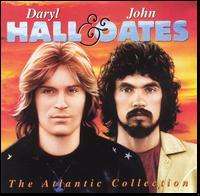The Atlantic Collection
The Atlantic Collection is a 1996 compilation album by Hall & Oates. While their 1977 compilation No Goodbyes was a collection of Hall & Oates' Atlantic Records recordings, this collection provides a more complete picture of that phase of Hall & Oates' history. This album contains the previously unreleased (but often bootlegged) track "Past Times Behind." It also has two rare songs "It's Uncanny" and "I Want to Know You for a Long Time," that were only released on the No Goodbyes album.
| The Atlantic Collection | ||||
|---|---|---|---|---|
 | ||||
| Compilation album by | ||||
| Released | January 23, 1996 | |||
| Genre | Pop | |||
| Label | Rhino/Atlantic Records | |||
| Hall & Oates chronology | ||||
| ||||
| Review scores | |
|---|---|
| Source | Rating |
| Allmusic | |
Track listing
- "Goodnight and Goodmorning" (Hall, Oates) - 3:18
- "I'm Sorry" (Hall, Oates) - 3:06
- "Fall in Philadelphia" (Hall) - 4:00
- "Waterwheel" (Hall) - 3:55
- "Lilly (Are You Happy)" (Hall, Oates) - 4:12
- "Past Times Behind" (Oates) - 3:07 (Previously unreleased)
- "When the Morning Comes" (Hall) - 3:13
- "Had I Known You Better Then" (Oates) - 3:25
- "Las Vegas Turnaround (The Stewardess Song)" (Oates) - 2:58
- "She's Gone" (Hall, Oates) - 5:16
- "I'm Just a Kid (Don't Make Me Feel Like a Man)" (Oates) - 3:19
- "Abandoned Luncheonette" (Hall) - 3:56
- "Lady Rain" (Hall, Oates) - 4:26
- "Laughing Boy" (Hall) - 3:30
- "It's Uncanny" (Hall) - 3:43
- "I Want to Know You for a Long Time" (Hall) - 3:20
- "Can't Stop the Music (He Played It Much Too Long)" (Oates) - 2:48
- "Is It a Star" (Hall, Oates) - 4:47
- "Beanie G and the Rose Tattoo" (Hall) - 3:02
- "You're Much Too Soon" (Hall) - 4:09
- "70's Scenario" (Hall) - 4:02
gollark: Surprisingly, no.
gollark: Also, there are some previous "comics" involving me which people may like.
gollark: Wow, ABR is famous.
gollark: (by heav)
gollark: You cannot get Minoteaur 5.
References
- Erlewine, Stephen Thomas. The Atlantic Collection at AllMusic
This article is issued from Wikipedia. The text is licensed under Creative Commons - Attribution - Sharealike. Additional terms may apply for the media files.